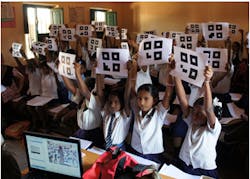QR codes used to capture student feedback
A team at Microsoft Research India (Bangalore, India) has developed a system that uses webcams and Quick Response (QR)-coded sheets of paper to recognize, collect, and analyze student responses to multiple-choice questions.
The technology is a new approach to classroom "polling" -- or asking students for feedback on how well they understand a question. Studies have shown that real-time evaluation of student performance helps to keep students engaged and helps teachers adjust the content and pacing of their lessons to accommodate the entire class.
The QR codes themselves are printed on 7-inch-by-7-inch cards that contain three black blocks to help the system locate the card and determine its orientation, and a code that contains a student's ID. In use, students can make one of four multiple choice answers to a question by holding up their card in one of four possible orientations.
A recognition algorithm in a PC attached to the webcam follows a series of steps to understand the card's meaning. It digitizes images of all the students' responses and then detects images that correspond to the three black blocks on the cards, verifying it is "seeing" an answer card. It then calculates the position and rotation in space of the card, and uses that information to ascertain the location of markings denoting information about the student and the answer.
Finally, it converts the digitized student record to a number that is used to tell the teacher the rates for successful answers.
More information on the system can be found here.
-- Dave Wilson, Senior Editor, Vision Systems Design
